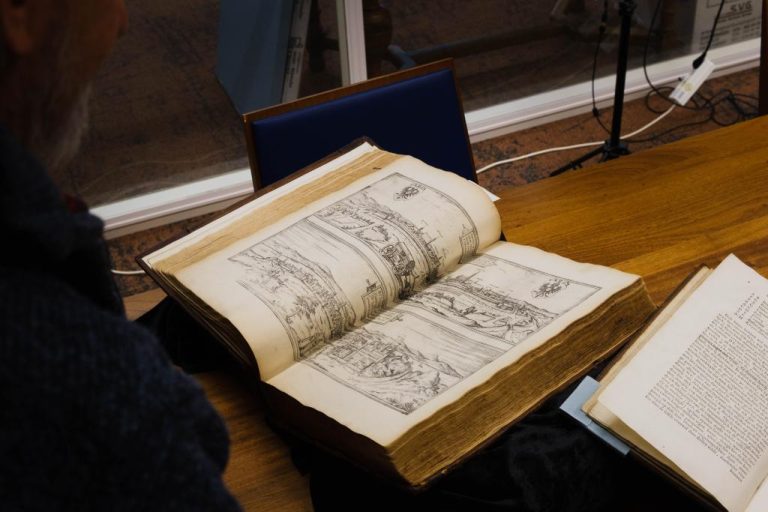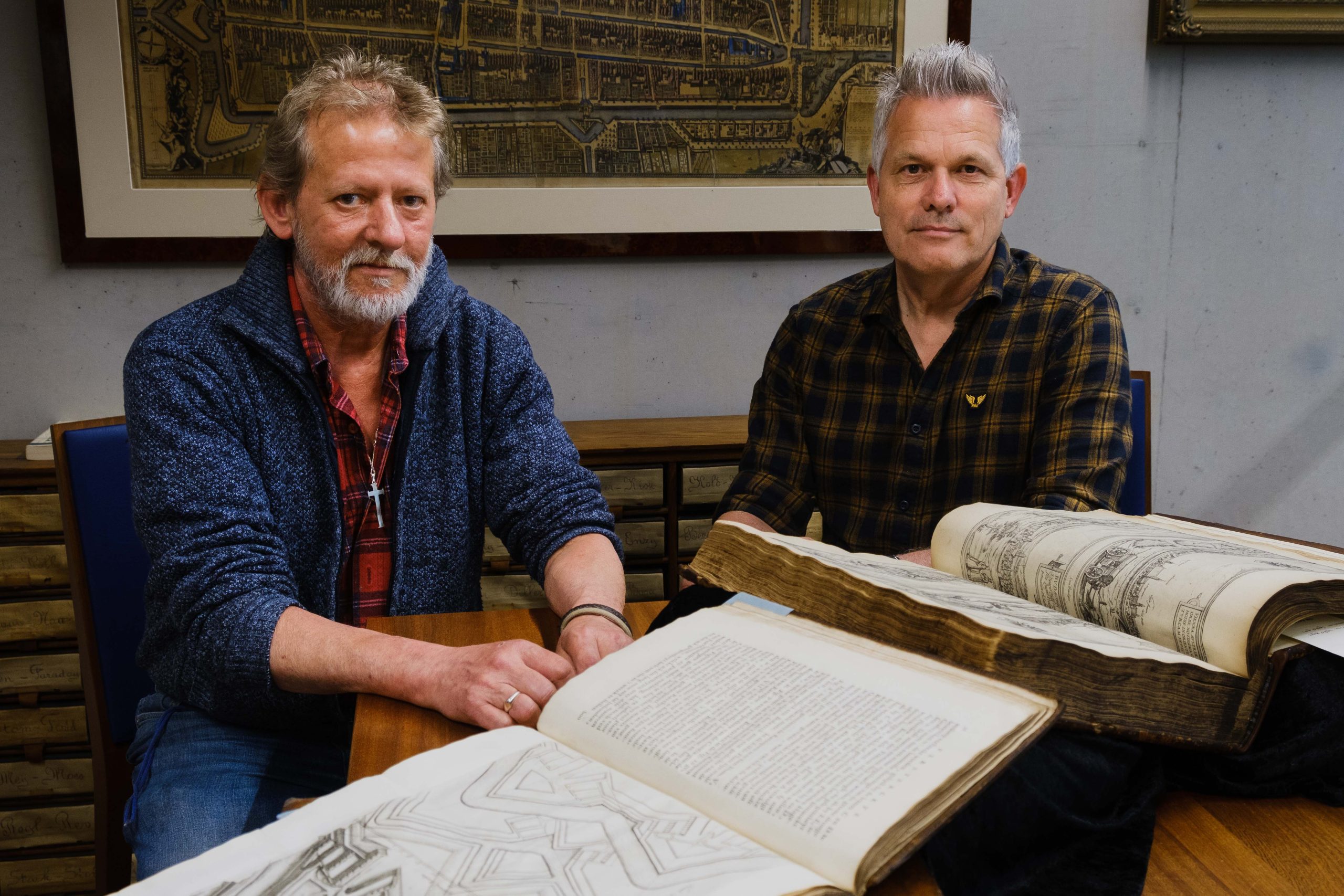The TU Delft Architecture Faculty burned down on 13 May 2008. Fifteen years later, Delta uses objects to look back. Part 2: books saved by Marcel Janssen and Hans Kaiser.
Marcel Janssen (left) and Hans Kaiser (right) retrieved century-old books from the burned Faculty of Architecture and the Built Environment. (Photo: Jaden Accord)
Marcel Janssen, a book restorer, was just stepping out of the shower when his mobile phone blasted through the house. It was Sunday morning, 18 May 2008. Someone from TU Delft was on the line. The person asked if he could immediately go to the burnt down Architecture and the Built Environment building to get historic books from the building. He did not need to stop and think. He got dressed, quickly ate something, and jumped on his bike. Hans Kaiser, a book binder in the book collection’s team, received a similar phone call. Like Janssen, he set off for the Faculty immediately.
The Faculty of Architecture and the Built Environment’s collection of 40,000 books included historic books from the 16th to 19th centuries. They included fist thick atlases and brown leather printed books containing hand drawn cityscapes. In the days following the fire, national and international media covered the disastrous consequences that the sea of flames was assumed to have had on the unique collection of books, prints, maps and other historic documents. The Volkskrant newspaper headline on Wednesday 14 May was ‘Brand verwoest unieke collectie’ (fire destroys unique collection) while De Morgen, a Belgian newspaper’s headline on Thursday 15 May was ‘Unieke Nederlandse architectuurcollectie zwaar gehavend door brand’ (unique Dutch architecture collection badly damaged by fire). Fortunately, much of the collection was saved by teams put together specially for this purpose. The members included Kaiser and Janssen.
‘The damage to the historical books was not as bad as we thought’
With another TU Delft colleague and someone from a demolition company, Kaiser and Janssen climbed into the building that same morning. Was that not dangerous? “Not really,” says Kaiser, “otherwise it would not have been permitted. The Oranje demolition company took charge.” The first time they went in was just for five minutes to assess the situation of the book collection. Kaiser and Janssen assumed the worst given the corridors drenched with water to extinguish the fire and the blackened books. “But it was not as bad as we thought,” reminisces Janssen. The condition of the historic book collection exceeded expectations. All those delicate brown leather books were still safely in their glass cabinets. “I broke into a huge smile,” says Janssen.


On the left in the photo you see city atlas by Georg Braun & Frans Hogenberg or Civitates orbis terrarum. The atlas consists of six volumes and this is volume 1 from 1572. The atlas consists of city descriptions, maps and city views. Volume 1 consists of 138 illustrations and includes the cities of Amsterdam, Aachen, Bruges and Brussels. (Photo: Jaden Accord)
Keys
He spent those first five minutes getting the keys to all the cabinets. “After that we had to wait, wait, wait,” says Kaiser, remembering the events. “That was because we needed some or other special permission. It came, then went, then came again.” After the rescue team was finally permitted to enter the building, they had exactly half an hour to empty the glass cabinets. “The time flew by,” says Janssen. “We were not permitted to talk and had to empty everything as quickly as we could into blue crates. And there was no time to pack each book separately.” One cabinet did not open with the key. “We had to break the glass.”
‘Occasionally you could hear glass falling down’
It felt very strange for the two of them to walk through an empty, burnt out and partially collapsed faculty building. “Everything was dark and you heard glass falling once in a while and the wind blowing through the building. It was deserted,” says Janssen. Kaiser adds that “The smell of burning was huge. Everything was dead.” That same day the blue crates full of old books were brought to the Library’s depot.
Multiple evacuations
A second and third removal round followed in which the print cabinet and the map room were cleared. Thousands of other books were also saved from the Architecture and the Built Environment library. Janssen explains that “Architecture and the Built Environment had listed the most important books and these were prioritised. Some books incurred water damage and were put into the shock freezer as a last attempt to save them.”
Anyone now requesting the books from the Library won’t notice anything odd. Only the Architecture and the Built Environment stamps and series numbers give a clue to their past in the fire. Are Kaiser and Janssen proud of having saved the books? “Oh yes,” answers Kaiser. “You only realise later that it was a major event and that you were part of it.” Janssen adds that “The book removal got little attention in the media. In the newspaper you read of all the things that were supposed to have been lost while you know that you had put everything neatly in the Library.”
- Many things were lost in the fire: master students’ maquettes, data files collected by PhD candidates, and professors’ historic archives. Also read part one of this series in which Emeritus Professor Franziska Bollerey talks about the loss of her historic archive.
Do you have a question or comment about this article?
a.m.debruijn@tudelft.nl


Comments are closed.